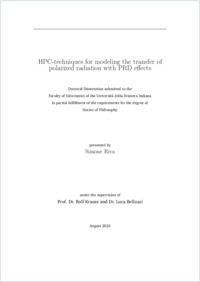HPC-techniques for modeling the transfer of polarized radiation with PRD effects
- Riva, Simone
- Krause, Rolf (Degree supervisor)
- Belluzzi, Luca (Degree supervisor)
- 2023
PhD: Università della Svizzera italiana
Computational physics
HPC
High-performance computing
Radiative transfer problem
Scattering processes
Solar physics
Chromosphere
Photosphere
Astrophysics
Numerical methods
Polarization profiles
Polarized radiation
English
One of the key problems in astrophysical research is to investigate the physical properties of astronomical objects by deciphering the information encoded in the radiation we receive from them. This requires modeling the spectral and polarization properties of the radiation they emit by numerically solving the so-called radiative transfer (RT) problem in given models of the object under consideration. In this thesis, we consider the problem of modeling the intensity and polarization profiles of strong lines of the solar spectrum, which encode information about two particular layers of the solar atmosphere: the chromosphere and the chromosphere-corona transition region. This requires solving the RT problem for polarized radiation under non-local thermodynamic equilibrium conditions and taking into account partial frequency redistribution (PRD) effects in the scattering processes. This is a notoriously challenging problem from a computational point of view and is generally solved by introducing simplifying approximations, both on the considered atmospheric models (e.g., isothermal, optically thin, cylindrically symmetric) and in the description of scattering processes (e.g., angle-average assumption). The thesis is carried out within the framework of a larger project that aims at developing a code for solving the RT problem for polarized radiation, taking PRD effects into account, in state-of-the-art 3D models of the solar atmosphere. In this thesis, we aim at developing methods for contribution to the emissivity including the PRD effects in the most general formulation. A key step to achieve this goal is to develop an efficient and reliable numerical method for the calculation of the emission vector of the RT equation, taking into account PRD effects in their most general formulation. This was the first main goal of the work. Subsequently, we applied the developed methods to quantitatively assess the suitability of an approximation that is commonly applied in the numerical solution of the RT problem with PRD effects. The core of the problem consists in integrating complex functions which highly depend on several parameters. We studied the basic functional components and analyzed a series of quadrature methods. Once the most convenient approaches have been identified we implemented them in highly optimized algorithms that take into account both the property of the integrand and the architecture of computer systems. The developed algorithms have been extensively tested and successfully implemented in both 1D and 3D RT codes. Using the 1D code, we modeled, for the first time, the intensity and polarization of various spectral lines in semi-empirical models of the solar atmosphere, accounting for angle-dependent PRD effects. These calculations, which also included magnetic fields of arbitrary strength and direction, as well as bulk velocities, unveiled a series of artifacts induced by the angle-averaged approximation, thus highlighting the importance of considering PRD effects in the most general formulation. One of the most remarkable results was found when modeling the polarizations signals produced by the forward scattering Hanle effect. The algorithm proved to be fully suitable also for the 3D code, which is presently run on an HPC system (CSCS).
- Collections
- Language
-
- English
- Classification
- Computer science and technology
- License
-
License undefined
- Open access status
- green
- Identifiers
-
- NDP-USI 2023INF012
- URN urn:nbn:ch:rero-006-119996
- ARK ark:/12658/srd1326079
- Persistent URL
- https://n2t.net/ark:/12658/srd1326079
Statistics
Document views: 266
File downloads:
- 2023INF012: 370
